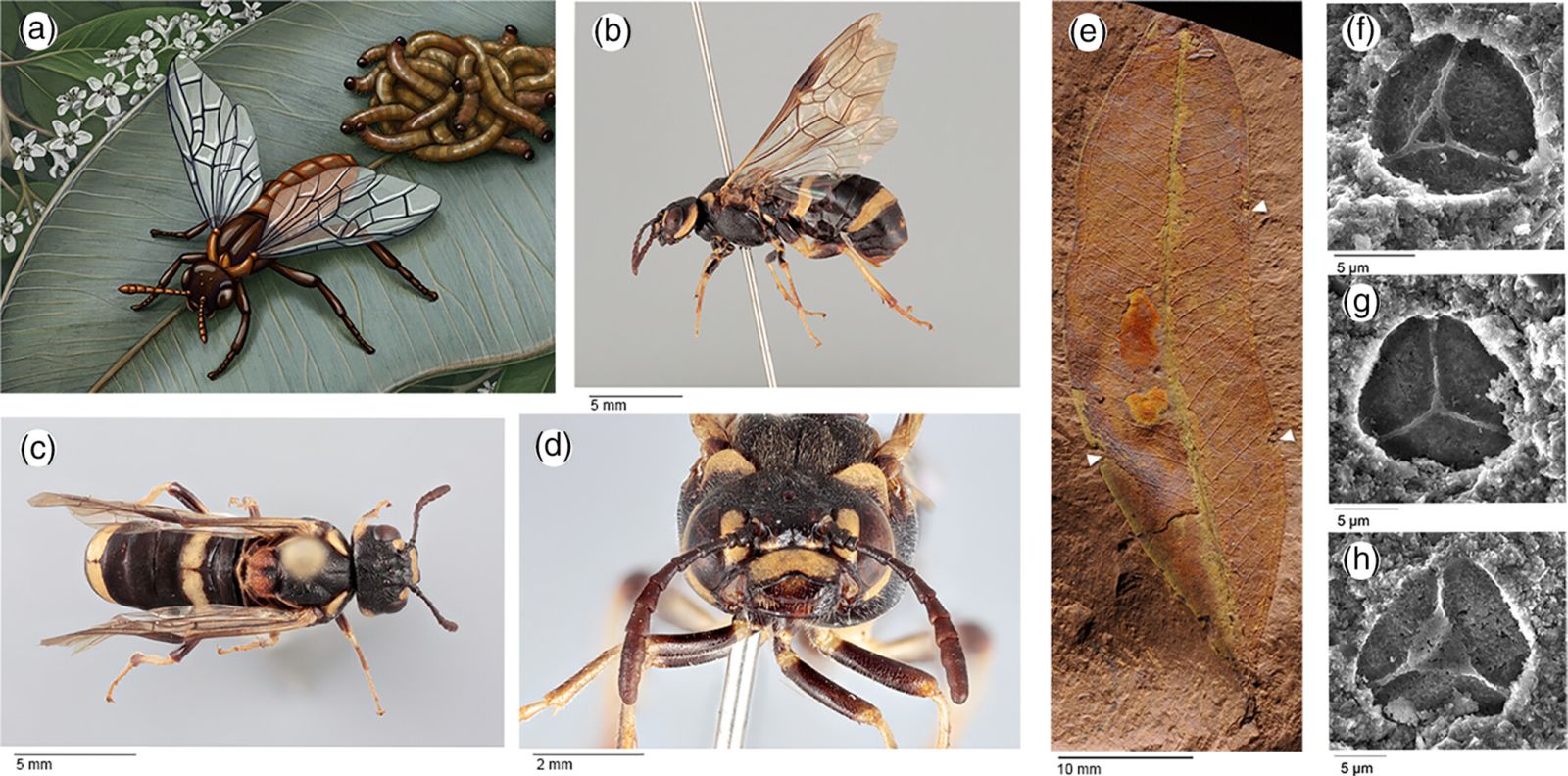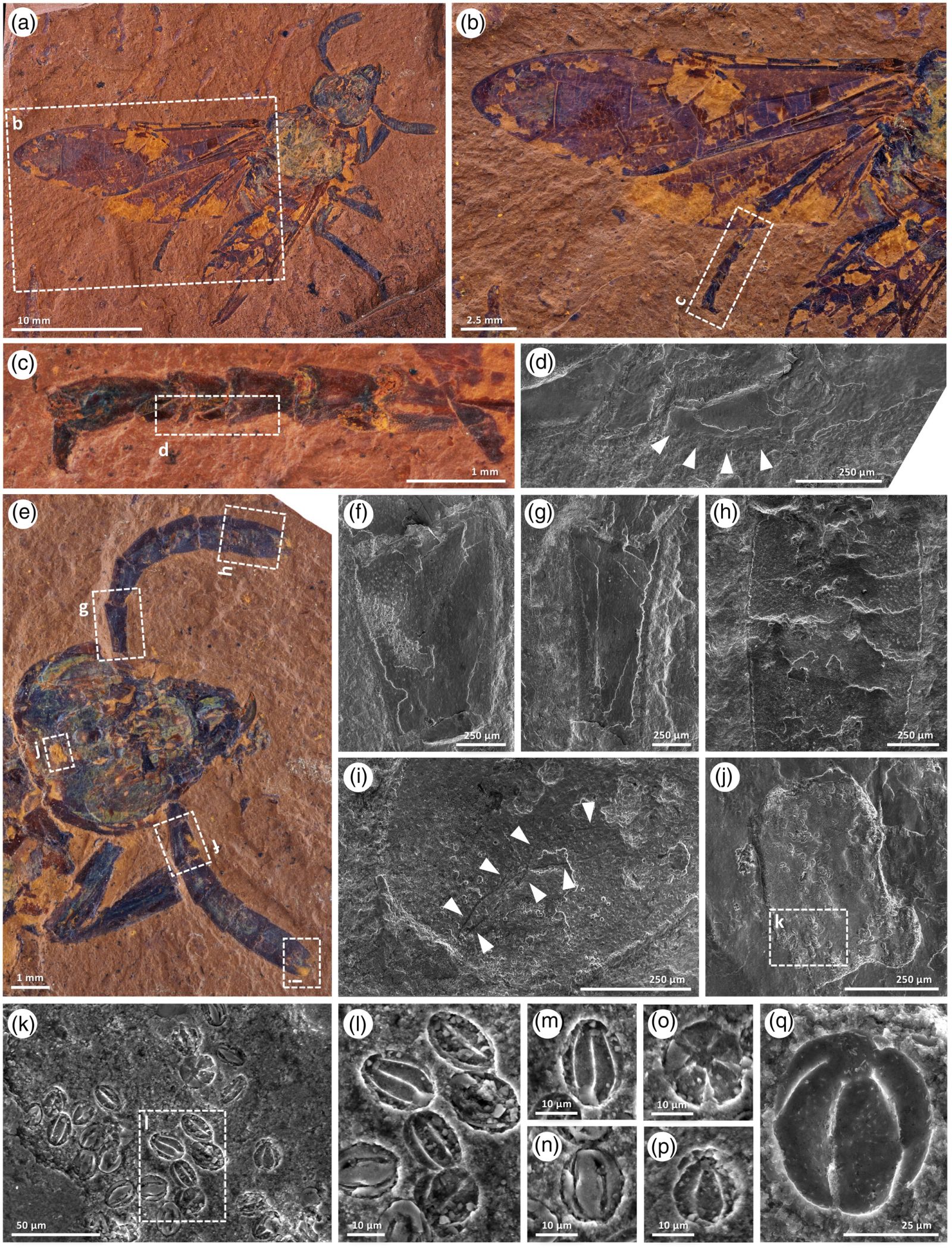Extinct for 16 million years, this animal resurfaces ⛏️
Published by Cédric,
Article author: Cédric DEPOND
Source: Systematic Entomology
Other Languages: FR, DE, ES, PT
Article author: Cédric DEPOND
Source: Systematic Entomology
Other Languages: FR, DE, ES, PT
Follow us on Google News (click on ☆)

A: Reconstruction of Baladi warru with larvae and Quintinia flowers (©2019 Alex Boersma).
B: Cerealces scutellata, side view (scale: 0.2 inches [5 mm]).
C: Cerealces scutellata, dorsal view (scale: 0.2 inches [5 mm]).
D: Cerealces scutellata, frontal view (scale: 0.08 inches [2 mm]).
E: Photo of a myrtaceous leaf with prominent intra-marginal vein and sebaceous glands, arrow tips showing insect damage.
F–H: Scanning electron micrographs of three different pollen grains: Myrtaceidites spp. (F, G) and Cupaniedites sp. (H).
Sawflies, often mistaken for flies, actually belong to the wasp family. Their saw-like ovipositor is used to lay eggs on host plants.
Voracious larvae then alter the vegetation by feeding on plant tissues. To classify Baladi warru among sawflies, scientists analyzed the fossil morphology and modern genetics. They thus determined that these insects date back to the Cretaceous period, about 100 million years ago.
This fossil also reveals pollen grains, evidence of interactions with a flowering plant known as Quintinia. Researchers can then reconstruct ancient pollinator networks and their ecosystems.
Sawflies likely migrated to Australia from Gondwana, the primordial continent that fragmented millions of years ago. This migration explains their presence in both Australia and South America. Better understanding these interactions helps trace the evolution of ecosystems and their pollinators. Studying Baladi warru allows researchers to explore the role of sawflies in present-day environments.

A: Holotype (overall view).
B: Wing.
C: Tarsal segments 1 to 5 of the left middle leg.
D: Tarsal segment 3 of the left middle leg (arrow tips indicating the plantula).
E: Head.
F: Left antennal segment 3.
G: Right antennal segment 3.
H: Left antennal segment.
I: Right antennal segment (arrow tips indicating unknown filamentous internal structures).
J: Vertex.
K–P: Pollen grains of Quintiniapollis psilatospora on the vertex, with various degrees of compression and filling, visible in equatorial (M, N), polar (O), or semi-equatorial (P) view.
Q: Isolated pollen of Q. psilatospora on another McGraths Flat sample.
Photos (A–C, E) and scanning electron micrographs (D, F–Q). The insets show the position and orientation of the enlarged views relative to the overall photos.
This discovery also raises questions about species adaptation in the face of environmental changes. This fossil thus provides a valuable window into past ecology, but also into tomorrow's ecosystems.
What is a sawfly and why is it unique?
Sawflies, often overlooked, actually belong to the large family of wasps, although they sometimes resemble flies. These insects are equipped with a saw-like ovipositor, a unique adaptation for laying eggs on host plants. Because of this feature, they are sometimes called "sawflies."
Sawflies play a crucial role in plant ecosystems: their larvae, which hatch on host plants, feed on surrounding plant tissues. This activity impacts the vegetation and can even influence plant structure, thus contributing to the ecological cycle of plants and their pollinators.